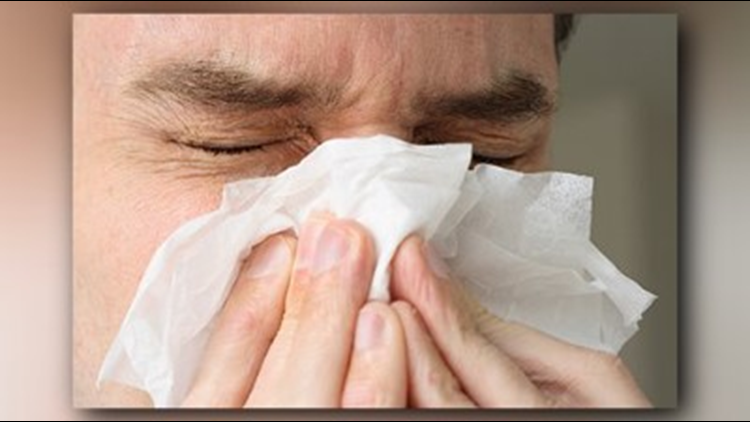TYLER, Texas — East Texas ranks in the top 10 markets nationwide with the most flu activity for the week ending on October 26, 2019.
According to the Walgreens Flu Index, the Tyler-Longview (Lufkin and Nacogdoches) area came in at No. 5 for the most flu activity in the nation.
The Walgreens Flu Index is not intended to illustrate levels or severity of flu activity, but rather illustrate which populations are experiencing the highest incidence of flu
Other Texas markets in the top 10 for flu activity include:
- Harlingen-Weslaco-Brownsville-McAllen (No. 3)
- Waco-Temple-Bryan (No. 7)
- Houston (No. 10)
Texas came in at No. 3 in the state/territories rankings, while Louisiana took the top spot.
WALGREENS FLU INDEX METHODOLOGY
The Walgreens Flu Index is compiled using retail prescription data for antiviral medications used to treat influenza across Walgreens locations nationwide. The data is analyzed at state and geographic market levels to measure absolute impact and incremental change of antiviral medications on a per store average basis, and does not include markets in which Walgreens has fewer than 10 retail locations.
WHAT CAUSES THE FLU?
There are two main types of influenza viruses, type A and type B, that cause influenza in humans.
COLD VS. FLU
The flu and the common cold are both respiratory illnesses, but they are caused by different viruses.
Because these two types of illnesses have similar symptoms, it can be difficult to tell the difference between them based on symptoms alone.
In general, the flu is worse than the common cold and symptoms are more intense. Colds are usually milder than the flu. Those with colds are more likely to have a runny or stuffy nose.
Colds generally do not result in serious health problems, such as pneumonia, bacterial infections or hospitalizations. The flu can have very serious associated complications.


WHAT ARE SYMPTOMS OF THE FLU?
The flu usually comes on suddenly, one to four days after the virus enters the body, and may include these symptoms:
- Fever or feeling feverish/chills
- Cough
- Sore throat
- Runny or stuffy nose
- Headache
- Muscle or body aches
- Tiredness (can be extreme)
Among children, otitis media (ear infection), nausea, vomiting, and diarrhea are common. Some persons who are infected with the influenza virus do not have symptoms.
WHEN CAN A PERSON SPREAD THE FLU TO OTHERS?
Most healthy adults who are ill with influenza may be able to infect other people beginning one day before symptoms develop and up to five to seven days after becoming sick. Children and persons with weakened immune systems might be able to infect other people for even a longer period of time. The virus can also be spread by people who are infected but have no symptoms.
TIPS ON PREVENTING THE FLU
According to the CDC, the single best way to prevent seasonal flu is to get vaccinated each year, but good health habits like covering your cough and washing your hands often can help stop the spread of germs and prevent respiratory illnesses like the flu.
The tips below will help you learn about steps you can take to protect yourself and others from the flu and help stop the spread of germs:
- Avoid close contact - Avoid close contact with people who are sick. When you are sick, keep your distance from others to protect them from getting sick too.
- Stay home when you are sick - If possible, stay home from work, school, and errands when you are sick. This will help prevent spreading your illness to others.
- Cover your mouth and nose - Cover your mouth and nose with a tissue when coughing or sneezing. It may prevent those around you from getting sick. Flu and other serious respiratory illnesses, like respiratory syncytial virus (RSV), whooping cough, and severe acute respiratory syndrome (SARS), are spread by cough, sneezing, or unclean hands.
- Avoid touching your eyes, nose and mouth - Germs are often spread when a person touches something that is contaminated with germs and then touches his or her eyes, nose, or mouth.
- Practice other good health habits - Clean and disinfect frequently touched surfaces at home, work or school, especially when someone is ill. Get plenty of sleep, be physically active, manage your stress, drink plenty of fluids, and eat nutritious food.
- Wash your hands - Washing your hands often will help protect you from germs. If soap and water are not available, use an alcohol-based hand rub.
PREVENTING THE FLU AT SCHOOL
Parents are encouraged to find out about plans their child’s school, child care program or college has if an outbreak of the flu or another illness occurs and whether flu vaccinations are offered on-site.
Make sure your child’s school, child care program or college routinely cleans frequently touched objects and surfaces and that they have a good supply of tissues, soap, paper towels, alcohol-based hand rubs and disposable wipes on-site.
Ask how sick students and staff are separated from others and who will care for them until they can go home.
PREVENTING THE FLU AT WORK
In order to avoid an outbreak at work, find out about your employer’s plans if an outbreak of flu or another illness occurs and whether flu vaccinations are offered on-site.
Routinely clean frequently touched objects and surfaces, including doorknobs, keyboards and phones, to help remove germs.
Make sure your workplace has an adequate supply of tissues, soap, paper towels, alcohol-based hand rubs and disposable wipes.
Train others on how to do your job so they can cover for you in case you or a family member gets sick and you have to stay home.
If you begin to feel sick while at work, go home as soon as possible.
To find a clinic near you that provides the flu vaccine, click here.



